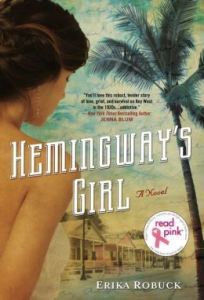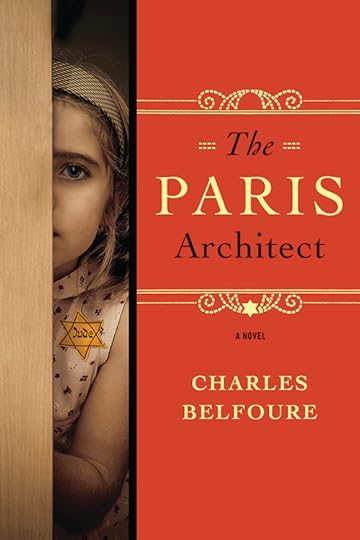Erika Robuck's Blog, page 15
October 19, 2013
Read Pink for Breast Cancer Awareness
“As one whose life has felt the shadow of breast cancer through two friends’ illnesses this year, it is an honor to be included in Penguin’s READ PINK campaign. It is my greatest hope that this contribution may be a part of raising awareness and finding a cure.” ~Erika Robuck”
Penguin Group (USA) LLC presents READ PINK®—its fourth year dedicated to the fight against breast cancer—with a $25,000 donation to The Breast Cancer Research Foundation® (BCRF)
I am honored my novel, HEMINGWAY’S GIRL, was chosen for this initiative with fellow authors Nora Roberts, Jodi Thomas, Carly Phillips, JoAnn Ross, Karen Rose, Catherine Anderson, Kate Jacobs, LuAnn McLane, Liane Moriarty, Alyson Richman, Sarah Jio, Penelope Lively, and spokesperson Karen White. Books bearing the READ PINK® seal can be found at participating retailers and online.
About READ PINK®
The Read Pink program was created by Penguin Group (USA) to promote public awareness of breast cancer, breast cancer research and to support and recognize the contributions of BCRF and its commitment to lead the fight against breast cancer – all in connection with the books you love. As one of the largest English-language trade book publishers in the world, we are committed to our readers who have shared in this struggle. Each year, Penguin’s Read Pink donation has sponsored 500 hours of research time.
Readers are invited to join Penguin Group (USA) and The Breast Cancer Research Foundation® in spreading the word about The Breast Cancer Research Foundation® by selecting a copy of these special editions.
Thank you.


September 30, 2013
Book Review: THE LIGHT IN THE RUINS

“Outside the open window, Cristina heard her mother and father speaking with Francesca on the terrace. Francesca was telling them about the visit from the two soldiers….Beside her, Alessia chirped happily that her grandfather and grandmother were back and raced downstairs. And so Cristina submerged her ears beneath the water and the world grew a little quieter; her hair fanned out atop the plane and she ran her fingers through it and was reminded of a goddess in a Renaissance painting. Her mind wandered far from the villa and the ruins and her unshakable sense that her world was about to change.” Chris Bohjalian, THE LIGHT IN THE RUINS
Publisher Synopsis
From the New York Times best-selling author of Midwives and The Sandcastle Girls comes a spellbinding novel of love, despair, and revenge—set in war-ravaged Tuscany.
1943: Tucked away in the idyllic hills south of Florence, the Rosatis, an Italian family of noble lineage, believe that the walls of their ancient villa will keep them safe from the war raging across Europe. Eighteen-year-old Cristina spends her days swimming in the pool, playing with her young niece and nephew, and wandering aimlessly amid the estate’s gardens and olive groves. But when two soldiers, a German and an Italian, arrive at the villa asking to see an ancient Etruscan burial site, the Rosatis’ bucolic tranquility is shattered. A young German lieutenant begins to court Cristina, the Nazis descend upon the estate demanding hospitality, and what was once was their sanctuary becomes their prison.
1955: Serafina Bettini, an investigator with the Florence police department, has her own demons. A beautiful woman, Serafina carefully hides her scars along with her haunting memories of the war. But when she is assigned to a gruesome new case—a serial killer targeting the Rosatis, murdering the remnants of the family one-by-one in cold blood—Serafina finds herself digging into a past that involves both the victims and her own tragic history.
My Recommendation
Many of my fellow bloggers have long been recommending Bohjalian’s work to me, and for reasons I cannot explain, this is the first of his novels I have read. It most certainly will not be my last.
Bohjalian is a writer of the highest caliber. His faraway historical settings are transportive and intoxicating, and his characters are realistic and flawed. THE LIGHT IN THE RUINS is one of those rare gems whose compelling plot is conveyed with richly readable and evocative prose.
I was entranced by life at the Villa Chimera before and during the war, and the losses of the family are felt acutely in the depiction of the ruins in the “present” of the book, 1955. The narratives run parallel for most of the novel, until the past catches up to the present in the form of a truly terrifying and vicious serial killer. (Note that the book is quite graphic.) Readers will stay up long after their bedtimes to reach the conclusion of this excellent work of literary suspense.
I give THE LIGHT IN THE RUINS my highest recommendation.
http://www.chrisbohjalian.com/
September 24, 2013
Book Review: MRS. POE

“Mrs. Poe smiled at me over the rim of her cup, her eyes a remarkable clear violet within the familial frame of dark lashes. Her skin, I noticed, was nearly as translucent and white as the cup itself. One could just make out the tracery of blue veins beneath it, giving one the odd sense that another creature altogether lurked just inside her flesh.” Lynn Cullen, MRS. POE
From the Publisher:
“New York, 1985. Mr. Poe’s “The Raven” is all the literary rage-the success of which a struggling poet like Frances Osgood can only dream. As a mother trying to support two children after her husband’s betrayal, Frances jumps at the opportunity to meet the mysterious Poe, if only to help her career. Although not a fan of his writing, Frances is overwhelmed by his magnetic presence-and the surprising revelation that he admires her work. What follows is a flirtation, then a seduction, then an illicit love affair. But when Edgar’s frail wife Virginia-a cousin half his age-insists on befriending Frances as well, the relationship becomes as dark and deceiving, as full of twists and turns, as one of Poe’s tales…and maybe, as Frances fears, every bit as deadly.
Closely based on Poe’s life and writings, and rich with authentic historical detail, MRS. POE is a novel of romantic obsession as passionate and enduring as its brilliant subject.”
My Recommendation:
Having lived just outside of Baltimore my entire life and being a fan of Poe’s macabre and romantic tales, I was thrilled to receive an early copy of MRS. POE for possible endorsement. From the first page, I was spellbound by the dark and captivating story of the famous writer, his sickly wife, and his troubled mistress.
Frances Osgood is the best kind of heroine: sympathetic, flawed, industrious, and conflicted. Her husband dallies with other women, leaving her to support their young children while desperately trying to preserve her reputation in society. Frances does not plan or wish to fall in love with E. A. Poe, but the spark of their shared creative processes as writers and the frightening attention of Poe’s child-bride are magnetic forces they can not control.
Like a story from the master himself, MRS. POE has suspicious characters, dark settings, and startling twists. By honoring Poe’s memory through style and theme, MRS. POE represents the best in historical fiction, and would no doubt be a novel in which Poe himself would approve.
If you enjoy gothic tales of fascination, creativity, and suspense, you will love MRS. POE.


September 19, 2013
Book Review: THE PARIS ARCHITECT
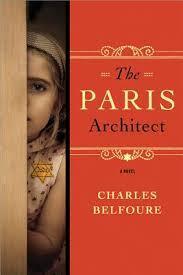
Publisher Description:
Like most gentiles in Nazi-occupied Paris, architect Lucien Bernard has little empathy for the Jews. So when a wealthy industrialist offers him a large sum of money to devise secret hiding places for Jews, Lucien struggles with the choice of risking his life for a cause he doesn’t really believe in. Ultimately he can’t resist the challenge and begins designing expertly concealed hiding spaces—behind a painting, within a column, or inside a drainpipe—detecting possibilities invisible to the average eye. But when one of his clever hiding spaces fails horribly and the immense suffering of Jews becomes incredibly personal, he can no longer deny reality.
My Recommendation
From the moment I saw the haunting cover of this novel, I knew I had to read it. The small Jewish girl hiding in plain sight says so much about the work of gifted architect, Lucien Bernard, the flawed protagonist of Charles Belfoure’s THE PARIS ARCHITECT.
Lucian is fairly despicable at the start of the novel. He no longer loves his wife, he has a mistress, and he does not care about the Jews being plagued by the Nazis in occupied France. He only cares about surviving by making as much money as possible, and growing his professional reputation.
His base need for a salary involves him as an architect working for enemies in the war. On one hand, he creates ingenius hiding spaces in apartments for Jews; on the other, he designs modern factories for Germans. It is all the same to him, as long as he gets paid, until he makes a personal connection with a Jew that ends disastrously.
I asked myself many times in the reading of this novel how I could care about such a heartless protagonist, but the riveting story, my curiosity about his innovation, and my wish to see his growth compelled me forward. I’m so glad it did.
This is not an easy book to read. Belfoure is unflinching in his portrayal of the animal nature of man, and of traitors, spies, and Nazis. The darkness is balanced, however, with a growing sense of hope and redemption throughout the narrative.
Booklist compares Belfoure’s writing to Ken Follett, and that is an excellent comparison in tension, intrigue, detail, and character. If you enjoy fast paced, graphic, and fascinating historical fiction, I recommend you read THE PARIS ARCHITECT.
Charles Belfoure and I will be at the Baltimore Book Festival on Sunday, September 29th, at the George Peabody Library. I hope you’ll stop by and pick up a copy of THE PARIS ARCHITECT.


September 11, 2013
THE PARIS ARCHITECT Blog Hop…
In 1942 Paris, gifted architect Lucien Bernard accepts a commission that will bring him a great deal of money – and maybe get him killed. But if he’s clever enough, he’ll avoid any trouble. All he has to do is design a secret hiding place for a wealthy Jewish man, a space so invisible that even the most determined German officer won’t find it.
Charles Belfoure’s debut historical thriller, THE PARIS ARCHITECT, releases next month, and has just received the honor of INDIE NEXT PICK status. I will be appearing with Charles at the Baltimore Book Festival on Sunday, September 29th, and I am eager to read this much buzzed about novel.
Today, I’ll present an excerpt from THE PARIS ARCHITECT, part two of the book’s “blog hop.” If you haven’t yet read part one, please visit Beth Fish Reads Blog. The rest of the blog hop schedule is as follows:
Thursday, September 12:
Devourer of Books
Friday, September 13:
Linus’s Blanket
Watch the book trailer: https://www.youtube.com/watch?v=g9FPlU47VbA
Preorder:
http://www.indiebound.org/book/9781402284311
http://www.amazon.com/Paris-Architect-Novel-Charles-Belfoure/dp/1402284314
http://www.barnesandnoble.com/w/paris-architect-charles-belfoure/1114780665
THE PARIS ARCHITECT
Pre-Pub Preview
Part II
As Lucien walked on in the glaring heat of the July afternoon, he looked up at the buildings clad in limestone (a sedimentary rock of the calcium carbonate family), with their beautiful rusticated bases, tall windows outlined in stone trim, and balconies with finely detailed wrought-iron designs supported on carved stone consoles. Some of the massive double doors of the apartment blocks were open, and he could see children playing in the interior courtyards, just as he had done when he was a boy. He passed a street-level window from which a black and white cat gazed sleepily at him.
Lucien loved every building in Paris—the city of his birth, the most beautiful city in the world. In his youth, he had roamed all over Paris, exploring its monuments, grand avenues, and boulevards down to the grimiest streets and alleys in the poorest districts. He could read the history of the city in the walls of these buildings. If that Kraut bastard’s aim had been off, never again would he have seen these wonderful buildings, walk these cobblestone streets, or inhale the delicious aroma of baking bread in the boulangeries.
Farther down the rue la Boétie, he could see shopkeepers standing back from their plate-glass windows—far enough to avoid being spotted from the street but close enough to have seen the shooting. A very fat man motioned to him from the entrance of the Café d’Eté. When he reached the door, the man, who seemed to be the owner, handed him a wet bar towel.
“The bathroom’s in the back,” he said.
Lucien thanked him and walked to the rear of the café. It was a typical dark Parisian café, narrow, a black-and-white-tiled floor with small tables along a wall, and a very poorly stocked bar on the opposite side. The Occupation had done the unthinkable in Paris: it had cut off a Frenchman’s most basic necessities of life—cigarettes and wine. But the café was such an ingrained part of his existence that he still went there daily to smoke fake cigarettes made from grass and herbs and drink the watered-down swill that passed for wine. The Café d’Eté patrons, who had probably seen what had happened, stopped talking and looked down at their glasses when Lucien passed, acting as if he’d been contaminated by his contact with the Germans. It reminded him of the time he’d been in a café when five German enlisted men blundered in. The place had gone totally silent, as if someone had turned off a switch on a radio. The soldiers had left immediately.
In the filthy bathroom, Lucien took off his suit jacket to begin the cleanup. A few blobs of blood the size of peas dotted the back of the jacket, and one was on the sleeve. He wet the towel with cold water and tried to blot out the Jew’s blood, but faint stains remained. This annoyed him—he only had one good business suit. A tall, handsome man with a full head of wavy brown hair, Lucien was quite particular about his clothes. His wife, Celeste, was clever about practical matters, though. She could probably get the bloodstains out of his jacket. He stood back and looked at himself in the mirror above the sink to make sure there wasn’t any blood on his face or in his hair, then suddenly looked at his watch and realized his appointment was in ten minutes. He put his jacket back on and threw the soiled towel in the sink.
Once in the street, he couldn’t help looking back at the corner where the shooting had taken place. The Germans and the body were gone; only a large pool of blood marked the spot of the shooting. The Germans were unbelievably efficient people. The French would have stood around the corpse, chatting and smoking cigarettes. Full rigor mortis would have set in by the time they had carted it away. Lucien almost started trotting but slowed his pace to a brisk walk. He hated being late, but he wasn’t about to be shot in the back of the skull because of his obsession with punctuality. Monsieur Manet would understand. Still, this meeting held the possibility of a job, and Lucien didn’t want to make a bad first impression.
Lucien had learned early in his career that architecture was a business as well as an art, and one ought not look at a first job from a new client as a one-shot deal but rather as the first in a series of commissions. And this one had a lot of promise. The man he was to meet, Auguste Manet, owned a factory that until the war used to make engines for Citroën and other automobile makers. Before an initial meeting with a client, Lucien would always research his background to see if he had money, and Monsieur Manet definitely had money. Old money, from a distinguished family that went back generations. Manet had tried his hand at industry, something his class frowned upon. Wealth from business was considered dirty, not dignified. But he had multiplied the family fortune a hundredfold, cashing in on the automobile craze, specializing in engines.
Manet was in an excellent position to obtain German contracts during the Occupation. Even before the German invasion in May 1940, a mass exodus had begun, with millions fleeing the north of the country to the south, where they thought they’d be safe. Many industrialists had tried unsuccessfully to move their entire factories, including the workers to the south. But Manet had remained calm during the panic and stayed put, with all his factories intact.
Normally, a defeated country’s economy ground to a halt, but Germany was in the business of war. It needed weapons for its fight with the Russians on the Eastern Front, and suitable French businesses were awarded contracts to produce war materiel. At first, French businessmen had viewed cooperation with the Germans as treason, but faced with a choice of having their businesses appropriated by the Germans without compensation or accepting the contracts, the pragmatic French had chosen the latter. Lucien was betting that Manet was a pragmatic man and that he was producing weapons for the Luftwaffe or the Wehrmacht. And that meant new factory space, which Lucien could design for him.
Before the war, whenever Lucien was on his way to meet a client for the first time, his imagination ran wild with visions of success—especially when he knew the client was rich. He tried to rein in his imagination now, telling himself to be pessimistic. Every time he got his hopes up high these days, they were smashed to bits. Like in 1938, when he was just about to start a store on the rue de la Tour d’Auvergne and then the client went bankrupt because of a divorce. Or the big estate in Orléans whose owner was arrested for embezzlement. He told himself to be grateful for any crumb of work that he could find in wartime.
Having nearly forgotten the incident with the Jew, Lucien’s mind began to formulate a generic design of a factory that would be quite suitable for any type of war production. As he turned up the avenue Marceau, he smiled as he always did whenever he thought of a new design.


September 3, 2013
Book Review: MARGOT
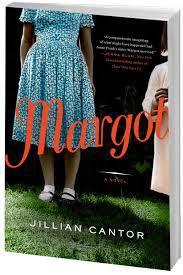
“I should begin with the simplest of truths: I am alive.” Jillian Cantor, MARGOT
MARGOT by Jillian Cantor comes out today from Riverhead/Penguin, and is 352 pages. I received an early copy for review, and I realized very quickly that I would recommend MARGOT on my blog. It was as heartfelt and captivating a novel as I’ve read in a long time.
MARGOT is an imagining of what might have happened if Anne Frank’s sister Margot had survived. It takes place in 1959 in Philadelphia, where Margot has recreated her life as Margie Franklin. In an attempt to outrun her past, she has forsaken her religion, and simply wishes to blend in to American society. The horrid tattoo on her forearm that she must cover at all costs and in all seasons, however, is a constant reminder and a kind of extended incarceration she experiences at the hands of the Nazis.
When the film about her sister’s diary suddenly opens at the movies, Margie’s attempts at hiding and suppressing her past become increasingly difficult. Friendships and loving relationships further deepen her lies, and she continues to hide until a case at the law firm where she works as a secretary forces her to confront her past or forever live as a victim of it.
MARGOT is my favorite kind of fiction. Using historical facts and people we know and love, Cantor fills in the lost details of their lives with her imagination, and reaps a beautiful and redeeming tale for a terrible chapter in history. Her scenes are immediate and realistic, and she brings Anne Frank and her sister to new life, while giving one of them a chance at a better future. This book not only feels like a prayer for Margot and Anne, but for the many voiceless men and women whose memory deserves recognition.
What is particularly moving about the novel is the glimpse at what life must have been like for survivors of the holocaust. So much of what is written about WWII takes place before and during the action of the war, or even at the time of the liberation. The continued hell of post-traumatic stress that the survivors must have faced through the daily reminders of their tattoos, hearing backfiring cars, or watching ashes fall from burning cigarettes is unimaginable. Cantor weaves in these details with clarity and care, giving the reader not only the facts of Margie’s new life, but the psychological implications of continuing to hide from her old one.
MARGOT is a courageous and well-written period piece with memorable characters. Whether or not you know Anne Frank through her diary, you must expand your understanding of her family and what one would hope for those like them by reading MARGOT. I give it my highest recommendation.


August 27, 2013
Book Review: TROUBLED DAUGHTERS, TWISTED WIVES

“…Lucille Smith was standing in her room in the servants’ quarters back of the house, buttoning the belt of a new white uniform. She touched her mouth lightly with lipstick.
‘You’re starting all over again, Lucille.’ she told herself in the mirror. ‘You’re going to have a happy, useful life from now on, and forget everything that was before.’
But there went her eyes too wide again, as though to deny her words. Her eyes looked much like her mother’s when they opened like that, and her mother was part of what she must forget. She must overcome the habit of stretching her eyes. It made her look surprised and uncertain, too, which was not at all the way to look around children.”
Patricia Highsmith, ‘The Heroine’
From Troubled Daughters, Twisted Wives: Stories from the Trailblazers of Domestic Suspense, Edited by Sarah Weinman
Publisher Description
Fourteen chilling tales from the pioneering women who created the domestic suspense genre
Murderous wives, deranged husbands, deceitful children, and vengeful friends. Few know these characters—and their creators—better than Sarah Weinman. One of today’s preeminent authorities on crime fiction, Weinman asks: Where would bestselling authors like Gillian Flynn, Sue Grafton, or Tana French be without the women writers who came before them?
In Troubled Daughters, Twisted Wives, Weinman brings together fourteen hair-raising tales by women who—from the 1940s through the mid-1970s—took a scalpel to contemporary society and sliced away to reveal its dark essence. Lovers of crime fiction from any era will welcome this deliciously dark tribute to a largely forgotten generation of women writers.
My Recommendation
I generally refuse books from publishers if they are not historical fiction, but I was intrigued by this collection for a number of reasons. First, I’m falling in love again with short stories. To paraphrase Edgar Allan Poe, it is best to read a story in a single sitting. In my increasingly busy life, I have a new appreciation for fiction that allows me to do this. Also, each story is selected and introduced by editor Sarah Weinman, who has an excellent Twitter account (@SarahW) dealing mostly with publishing and current events.
In Troubled Daughters, Twisted Wives, Weinman introduces each story with a brief bio and historical context. The biographies of the women featured in the collection are every bit as interesting as their chilling tales, and will inspire the reader to want to learn more about them and read more from them. They are arranged loosely by age of subject, and from the terrifying teen in the opening story to the home-bound elderly woman in the last, each tale explores a different dimension of madness and crime.
One does not need to love the suspense genre to enjoy Troubled Daughters, Twisted Wives. If you have an appreciation for stories of psychological terror or are interested in women writers from the past who opened doors for their contemporary counterparts, you must read this collection.
http://www.sarahweinman.com/confessions/


August 20, 2013
Book Review: THE GIRL YOU LEFT BEHIND

“[The Kommandant] held up the lamp, and it was dimly illuminated in pale gold light: the portrait Edouard had painted of me when we were first married. There I was, in that first year, my hair thick and lustrous around my shoulders, my skin clear and blooming, gazing out with the self-possession of the adored. I had brought it down from its hiding place several weeks before, telling my sister I was damned if the Germans would decide what I should look at in my own home.
He lifted the lamp a little higher so that he could see it more clearly. Do not put it there, Sophie, Helene had warned. It will invite trouble.”
Jojo Moyes, THE GIRL YOU LEFT BEHIND
Publisher Description:
What happened to the girl you left behind?
In 1916 French artist Edouard Lefevre leaves his wife Sophie to fight at the Front. When her town falls into German hands, his portrait of Sophie stirs the heart of the local Kommandant and causes her to risk everything – her family, reputation and life – in the hope of seeing her true love one last time.
Nearly a century later and Sophie’s portrait is given to Liv by her young husband shortly before his sudden death. Its beauty speaks of their short life together, but when the painting’s dark and passion-torn history is revealed, Liv discovers that the first spark of love she has felt since she lost him is threatened…
In The Girl You Left Behind two young women, separated by a century, are united in their determination to fight for the thing they love most – whatever the cost.
My Recommendation:
370 pages devoured in three days. That is my review of THE GIRL YOU LEFT BEHIND in its simplest expression.
Truly, this dual period novel is one of the best I’ve read in this form in a long time. The tension in both the past and the present is often unbearable, and the characters are unique, flawed, and intensely likable. The stories are full of connections and surprises, and the weight of what is left unsaid brings tremendous power to the narrative.
The opening scene in occupied France during the first World War is a life or death moment of sheer terror, yet Moyes introduces a humorous surprise that brilliantly shows the traits of the characters and the depth of their bonds. The emotions are raw and immediate, and each time the book is cracked, the reader becomes immersed in the colorful lives of those inhabiting its pages.
Vast in scope, deep in development, engaging and startling at every turn, THE GIRL YOU LEFT BEHIND is a novel that will appeal to readers across genres. This is the first book I’ve read by Jojo Moyes, but it will not be the last. I give THE GIRL YOU LEFT BEHIND my highest recommendation.


August 14, 2013
Book Review: RIVER OF DUST
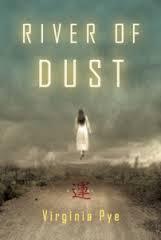
“[T]hey both looked out at the night. The restless grasses hovered nearby, and the mountains rose, a shadow of a shadow in the distance. To find the boy, they would have to cross over them and then traverse much more.”
Virginia Pye, RIVER OF DUST
Publisher Description:
On the windswept plains of northwestern China not long after the Boxer Rebellion, Mongol bandits swoop down upon an American missionary couple and kidnap their small child. As the Reverend sets out in search of the boy, he quickly loses himself in the rugged, corrupt, drought-stricken countryside populated by opium dens, sly nomadic warlords and traveling circuses. Grace, his young wife, pregnant with their second child, takes to her sick bed in the mission compound, where visions of her stolen child and lost husband begin to beckon to her from across the plains.
The foreign couple’s capable and dedicated Chinese servants, Ahcho and Mai Lin, accompany and eventually lead them through dangerous territory to find one another again. With their Christian beliefs sorely tested, their concept of fate expanded, and their physical health rapidly deteriorating, the Reverend and Grace may finally discover an understanding between them that is greater than the vast distance they have come.
Inspired in part by journals of her grandfather, who was himself an early missionary in China, Virginia Pye delivers a hypnotic, emotionally powerful, spiritually resonant debut that is at once both lyrical and dynamic.
My Recommendation
I found RIVER OF DUST terrifying and captivating. As a mother, I felt the horror of the kidnapping scene so acutely I couldn’t sleep. As a wife, I felt how Grace’s heart left her on every new quest her husband began to find their boy. As a woman, I appreciated the power Grace assumed over the course of the book in spite of her failing health. As a reader and writer, I was in awe of the transformations of the characters–men and women deteriorating in the faith they had come to teach, becoming more savage as their community failed, yet somehow growing in their humanity.
Pye was inspired by her grandfather’s missionary work in China in the early twentieth century, less than a decade after the Boxer Rebellion. Her descriptions of the living conditions of the foreigners and the Chinese, the relentless dust of the Shanxi Province plains, and the opium dens are vivid, and her characters are unique and fascinating.
RIVER OF DUST would be an ideal choice for book clubs because it is beautifully written and thought provoking. Readers interested in history, Americans abroad, and the struggles of missionaries will highly enjoy RIVER OF DUST.
For more on the author and the novel, visit http://www.virginiapye.com/ .


August 9, 2013
Sue Monk Kidd’s Forthcoming Novel!!!
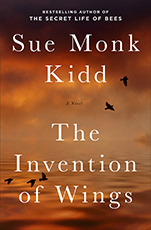
When asked which books started my love affair with historical fiction and strong female characters, Sue Monk Kidd’s THE SECRET LIFE OF BEES immediately jumps to mind. I’ll never forget how that novel made me feel reading it for the first time. It is the kind of tale that immerses the reader in a place in time the moment the pages are opened.
Kidd’s forthcoming novel, THE INVENTION OF WINGS, will be published in January, and I am beyond excited to dig in. It is described as a story with two unforgettable women–a slave and her young mistress–in early nineteenth-century Charleston, navigating the tumultuous waters of abolition and women’s rights.
For more information, here is a link to Sue Monk Kidd’s website: http://www.suemonkkidd.com/ and Twitter account: https://twitter.com/suemonkkidd
Of Sue Monk Kidd’s books, which is your favorite?

